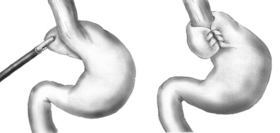Laparoscopic fundoplication
| Nissen fundoplication | |
|---|---|
| Intervention | |

Diagram of a Nissen fundoplication.
|
|
| ICD-9-CM | 44.66, 44.67 |
A Nissen fundoplication, or laparoscopic Nissen fundoplication when performed via laparoscopic surgery, is a surgical procedure to treat gastroesophageal reflux disease (GERD) and hiatal hernia. In GERD, it is usually performed when medical therapy has failed; but, with a Type II (paraesophageal) hiatus hernia, it is the first-line procedure. The Nissen fundoplication is total (360°), but partial fundoplications known as Thal (270° anterior), Belsey (270° anterior transthoracic), Dor (anterior 180–200°), Lind (300° posterior), and Toupet fundoplications (posterior 270°) are alternative procedures with somewhat different indications and outcomes.
Dr. Rudolph Nissen (1896–1981) first performed the procedure in 1955 and published the results of two cases in a 1956 Swiss Medical Weekly. In 1961 he published a more detailed overview of the procedure. Nissen originally called the surgery "gastroplication." The procedure has borne his name since it gained popularity in the 1970s.
In a fundoplication, the gastric fundus (upper part) of the stomach is wrapped, or plicated, around the lower end of the esophagus and stitched in place, reinforcing the closing function of the lower esophageal sphincter. The esophageal hiatus is also narrowed down by sutures to prevent or treat concurrent hiatal hernia, in which the fundus slides up through the enlarged esophageal hiatus of the diaphragm.
In a Nissen fundoplication, also called a complete fundoplication, the fundus is wrapped the entire 360 degrees around the esophagus. In contrast, surgery for achalasia is generally accompanied by either a Dor or Toupet partial fundoplication, which is less likely than a Nissen wrap to aggravate the dysphagia that characterizes achalasia. In a Dor (anterior) fundoplication, the fundus is laid over the top of the esophagus; while in a Toupet (posterior) fundoplication, the fundus is wrapped around the back of the esophagus.
...
Wikipedia
